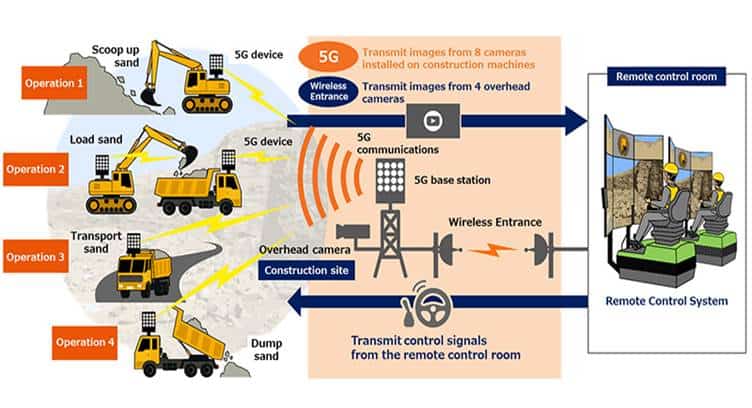NEC, KDDI and Obayashi, a major Japanese construction company announced that they had successfully carried out an operation where 5G was used to remotely control two construction machines in a cooperative manner.
This field experiment was conducted in a part of the construction area of Aigawa Dam, which is under construction, in Ibaraki, Osaka from December 3 to 14, 2018.
At the time of a disaster, a swift recovery of social infrastructure is urgently needed under risks of secondary disasters such as mudslides. Therefore, remote control systems for construction machinery are expected to be used to secure safety of operation sites. However, existing remote control systems using Wi-Fi bring a time lag between remote control of construction machinery and transmission of images, which more exhausts operators and reduces work efficiency compared to onboard operations. Especially, it is essential to minimize a time lag in order to realize smooth operability equivalent to onboard operations when two construction machines are used for cooperative operations, because it requires operators to discern the distance between two machines.
This field experiment applied the key features of 5G communications, such as high speed, high capacity, and low-latency communication, to remotely control two different construction machines, a backhoe and a crawler dump, and successfully transported sand. A total of eight cameras, three 2K forward cameras and one omnidirectional camera for each, were installed on two construction machines in order to transmit images from the cameras and sound data in real time using 5G. The experiment proved that remote control can be performed equivalently to onboard operations.
Furthermore, considering a case where fiber-optic lines cannot be used at the time of disaster, the 5G base station and the remote control room, separated by about 750 meters, were connected through the wireless entrance network. It was used for backhaul communication of 5G and also transmitted images from four overhead cameras. In addition, an in-vehicle 5G base station was introduced to build a remote control room in a mobile trailer house. This demonstrates that a remote control environment can be immediately built at disaster-hit areas and then recovery works can be carried on swiftly and safely.
Meanwhile, an interactive voice control system was introduced in ICT construction for the first time in Japan, and construction machinery using a 5G system was successfully operated remotely only by a voice control system. The experiment confirms that, as a result, the system enables a single operator to operate two construction machines simultaneously, which compensates for the lack of skilled construction workers and contributes to greatly improving work efficiencies.
KDDI, Obayashi, and NEC succeeded in the field experiment in remote construction using 5G and 4K 3D monitoring for the first time in Japan in February 2018 (Note 2). The companies aim to realize advanced construction technologies utilizing 5G through a number of field experiments.


















